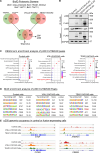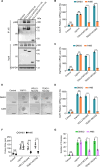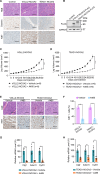This is a preprint.
VGLL2 and TEAD1 fusion proteins drive YAP/TAZ-independent tumorigenesis by engaging p300
- PMID: 38746415
- PMCID: PMC11092657
- DOI: 10.1101/2024.05.01.592016
VGLL2 and TEAD1 fusion proteins drive YAP/TAZ-independent tumorigenesis by engaging p300
Update in
-
VGLL2 and TEAD1 fusion proteins identified in human sarcoma drive YAP/TAZ-independent tumorigenesis by engaging EP300.Elife. 2025 May 8;13:RP98386. doi: 10.7554/eLife.98386. Elife. 2025. PMID: 40338073 Free PMC article.
Abstract
Studies on Hippo pathway regulation of tumorigenesis largely center on YAP and TAZ, the transcriptional co-regulators of TEAD. Here, we present an oncogenic mechanism involving VGLL and TEAD fusions that is Hippo pathway-related but YAP/TAZ-independent. We characterize two recurrent fusions, VGLL2-NCOA2 and TEAD1-NCOA2, recently identified in spindle cell rhabdomyosarcoma. We demonstrate that in contrast to VGLL2 and TEAD1, the fusion proteins are strong activators of TEAD-dependent transcription, and their function does not require YAP/TAZ. Furthermore, we identify that VGLL2 and TEAD1 fusions engage specific epigenetic regulation by recruiting histone acetyltransferase p300 to control TEAD-mediated transcriptional and epigenetic landscapes. We showed that small molecule p300 inhibition can suppress fusion proteins-induced oncogenic transformation both in vitro and in vivo. Overall, our study reveals a molecular basis for VGLL involvement in cancer and provides a framework for targeting tumors carrying VGLL, TEAD, or NCOA translocations.
Keywords: Hippo signaling pathway; NCOA2; TEAD1; VGLL2; fusion; p300.
Conflict of interest statement
Disclosure and competing interests statement Dr. Xu Wu has a financial interest in Tasca Therapeutics, which is developing small molecule modulators of TEAD palmitoylation and transcription factors. Dr. Wu’s interests were reviewed and are managed by Mass General Hospital, and Mass General Brigham in accordance with their conflict of interest polices.
Figures






Similar articles
-
VGLL2 and TEAD1 fusion proteins identified in human sarcoma drive YAP/TAZ-independent tumorigenesis by engaging EP300.Elife. 2025 May 8;13:RP98386. doi: 10.7554/eLife.98386. Elife. 2025. PMID: 40338073 Free PMC article.
-
Leveraging Hot Spots of TEAD-Coregulator Interactions in the Design of Direct Small Molecule Protein-Protein Interaction Disruptors Targeting Hippo Pathway Signaling.Pharmaceuticals (Basel). 2023 Apr 13;16(4):583. doi: 10.3390/ph16040583. Pharmaceuticals (Basel). 2023. PMID: 37111340 Free PMC article. Review.
-
A Novel Irreversible TEAD Inhibitor, SWTX-143, Blocks Hippo Pathway Transcriptional Output and Causes Tumor Regression in Preclinical Mesothelioma Models.Mol Cancer Ther. 2024 Jan 3;23(1):3-13. doi: 10.1158/1535-7163.MCT-22-0681. Mol Cancer Ther. 2024. PMID: 37748190
-
Hippo pathway inhibition by blocking the YAP/TAZ-TEAD interface: a patent review.Expert Opin Ther Pat. 2018 Dec;28(12):867-873. doi: 10.1080/13543776.2018.1549226. Epub 2018 Dec 2. Expert Opin Ther Pat. 2018. PMID: 30482112 Review.
-
Molecular and structural characterization of a TEAD mutation at the origin of Sveinsson's chorioretinal atrophy.FEBS J. 2019 Jun;286(12):2381-2398. doi: 10.1111/febs.14817. Epub 2019 Apr 11. FEBS J. 2019. PMID: 30903741
References
-
- Alaggio R, Zhang L, Sung YS, Huang SC, Chen CL, Bisogno G, Zin A, Agaram NP, LaQuaglia MP, Wexler LH, Antonescu CR. 2016. A Molecular Study of Pediatric Spindle and Sclerosing Rhabdomyosarcoma: Identification of Novel and Recurrent Vgll2-Related Fusions in Infantile Cases. Am J Surg Pathol 40: 224–35. DOI: 10.1097/pas.0000000000000538 - DOI - PMC - PubMed
-
- Bamforth SD, Bragança J, Eloranta JJ, Murdoch JN, Marques FI, Kranc KR, Farza H, Henderson DJ, Hurst HC, Bhattacharya S. 2001. Cardiac Malformations, Adrenal Agenesis, Neural Crest Defects and Exencephaly in Mice Lacking Cited2, a New Tfap2 Co-Activator. Nat Genet 29: 469–74. DOI: 10.1038/ng768 - DOI - PubMed
Publication types
Grants and funding
LinkOut - more resources
Full Text Sources
Molecular Biology Databases
Miscellaneous
